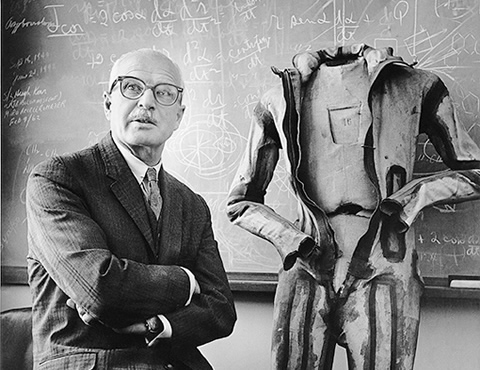Given the airborne talents of astronauts and fighter pilots, it’s easy to overlook the role of their high-tech uniforms. This picture from 1962 shows Wilbur Rounding Franks, a professor in U of T’s Banting and Best Department of Medical Research, posing with the Franks Flying Suit. It is the first anti-gravity or G-suit used in combat, and is still the foundational design for contemporary fighter-pilot and astronaut pressure suits.
Franks earned his BA at Victoria College in 1924, graduated from medical school at U of T in 1928 and worked in cancer research. After the death of his mentor Frederick Banting in 1941, Franks continued Banting’s research into aviation medicine and the problem of Allied fighter pilots losing consciousness during high-speed exercises. The pilots were subject to immense gravitational forces, making it difficult for the heart to pump blood to the brain.
Franks initially came up with the idea of a water-filled G-suit. By filling an outer layer with water that pressed on the legs and abdomen to prevent blood from pooling in the lower parts of the body, Franks could keep the pilots’ blood circulating normally. His preliminary tests were on mice surrounded by condoms filled with water, and Franks eventually subjected himself to a barrage of successful tests in real aircraft. Later designs used air pressure instead of water pressure, and included an inflatable bladder. The Franks Flying Suit was first used in combat by the Royal Navy Fleet Air Arm in an invasion of North Africa in November 1942.
Recent Posts
U of T’s 197th Birthday Quiz
Test your knowledge of all things U of T in honour of the university’s 197th anniversary on March 15!
Are Cold Plunges Good for You?
Research suggests they are, in three ways
Work Has Changed. So Have the Qualities of Good Leadership
Rapid shifts in everything from technology to employee expectations are pressuring leaders to constantly adapt






